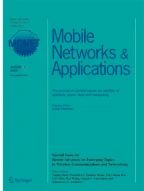Abstract
A deployment of femtocells that is harmonic with its environment is a challenging issue. In this respect, interference management has traditionally been in the spotlight. However, architectural improvements for efficient femtocell deployments, despite being equally relevant, have received less attention. This paper presents a system architecture conceived for efficiently deploying femtocells in the form of Networks of Femtocells (NoFs). In this scenario, a group of femtocells in the same administrative domain cooperate towards a global performance improvement. Key to this improvement is the introduction of a new entity called Local Femto Gateway (LFGW) and the modifications in the femtocells in the local network. This allows offloading a high volume of control and data traffic from the core network of the mobile operator to the functional entities in the NoF. In particular, this paper focuses on building blocks related to traffic and mobility management. A two-level routing approach is discussed. The highest level is carried out by the mobile network layer. It is in charge of (1) determining the communication endpoints in the form of GPRS Tunneling Protocol (GTP) tunnel endpoint IDs, and (2) forwarding packets between tunnels belonging to the same Evolved Packet System (EPS) bearer at the appropriate nodes. Solutions for efficient handoff, local breakout, and local location management are presented for this level of routing. On the other hand, the lowest-level routing is carried out by the transport network layer. This level is in charge of finding the path between the above endpoints by efficiently using the local transport network that interconnects the femtocells in the NoF. A distributed routing solution for a large-scale, all-wireless network of femtocells is also presented. Overall, these architectural improvements render NoFs a promising approach for efficient traffic management in large-scale femtocell deployments, hence making them a scalable solution.
Similar content being viewed by others
References
Chandrasekhar V, Andrews JG, Gatherer A (2008) Femtocell networks: a survey. IEEE Communications Magazine 46(9):59–67
Broadband evolved FEMTO networks (BeFEMTO) project. INFSO-ICT-248523. http://www.ict-befemto.eu. Accessed 29 March 2012
Zdarsky F, Maeder A, Al-Sabea S, Schmid S (2011) Localization of data and control plane traffic in enterprise femtocell networks, in Proceedings of IEEE 73rd Vehicular Technology Conference (VTC Spring 2011), 15–18 May, 2011, Budapest (Hungary)
Broadband evolved FEMTO networks (BeFEMTO) project, “The BeFEMTO System Architecture”, deliverable D2.2. December 2011. http://www.ict-befemto.eu/publications/deliverables.html. Accessed 29 March 2012
ETSI ES 282 001 (2009) “Telecommunications and Internet converged Services and Protocols for Advanced Networking (TISPAN); NGN Functional Architecture,” v3.3.0
3GPP TS 23.401 (2011) “General Packet Radio Service (GPRS) enhancements for Evolved Universal Terrestrial Radio Access Network (E-UTRAN) access, v.8.14.0 (Release 8)”
Wang L, Zhang Y, Wei Z (2009) Mobility management schemes at radio network layer for LTE femtocells, in Proceedings of IEEE 69th Vehicular Technology Conference (VTC Spring 2009), 26-29 April, 2009, Barcelona (Spain)
Zhang H, Ma W, Li W, Zheng W, Wen X, Jiang C (2011) Signalling cost evaluation of handover management schemes in LTE-advanced femtocell, in Proceedings of IEEE 73rd Vehicular Technology Conference (VTC Spring 2011), 15–18 May, 2011, Budapest (Hungary)
Broadband evolved FEMTO networks (BeFEMTO) project, “Femtocell Access Control, Networking, Mobility, and Management Concepts”, deliverable D5.1. December 2010. http://www.ict-befemto.eu/publications/deliverables.html. Accessed 29 March 2012
Ferragut J, Mangues J (2012) A Self-organized tracking area list mechanism for Large-scale networks of femtocells, in Proceedings of IEEE International Conference on Communications (ICC 2012), 10–15 June, 2012, Ottawa (Canada)
Broadband evolved FEMTO networks (BeFEMTO) project, “Evaluation report of femtocells networking, mobility and management solutions”, deliverable D5.3. June 2012. http://www.ict-befemto.eu/publications/deliverables.html
Neely MJ (2010) Stochastic network optimization with application to communication and queueing systems. Synthesis lectures on communication networks. Morgan & Claypool Publishers, San Rafael
Núñez J, Mangues J, Portolés M (2011) Studying practical Any-to-any Backpressure Routing in WiFi Mesh from a Lyapunov Optimization Perspective, in Proceedings of the 8th International Conference on Mobile Ad-hoc and Sensor Systems (IEEE MASS), October 16–22, 2011, Valencia (Spain)
Núñez J, Mangues J Distributed Lyapunov Drift-plus-penalty for WiFi Mesh Networks with Adaptive Penalty Weight. In proceedings of IEEE HotMesh 2012 within IEEE WoWMON
Acknowledgments
This work has been partially supported by the Generalitat de Catalunya under grant 2009-SGR-940, the Spanish Ministry of Science and Innovation under grant TEC2011-29700-C02-01, the Spanish Ministry of Education under grant FPU AP2009-5000, and performed in the framework of the ICT project ICT-4-248523 BeFEMTO, which is partly funded by the European Union. The authors would like to acknowledge the contributions of their colleagues from the BeFEMTO consortium.
Author information
Authors and Affiliations
Corresponding author
Rights and permissions
About this article
Cite this article
Ferragut, J., Mangues-Bafalluy, J., Núñez-Martínez, J. et al. Traffic and Mobility Management in Networks of Femtocells. Mobile Netw Appl 17, 662–673 (2012). https://doi.org/10.1007/s11036-012-0396-9
Published:
Issue Date:
DOI: https://doi.org/10.1007/s11036-012-0396-9
